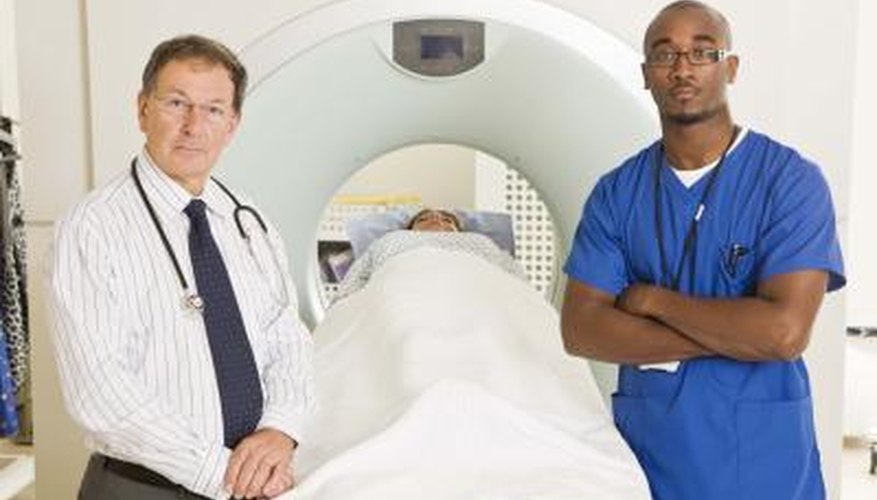Magnetic Resonance Imaging (MRI) is a medical imaging technique that allows doctors to look inside the body.
The MRI scanner is a highly sophisticated piece of equipment that uses magnets, radio waves and computer technology to produce images. While, in many cases, MRI exams have succeeded in improving patient care, the equipment is quite expensive.
Cost
MRI equipment varies in cost, depending on the strength of the scanner. Scanners with more strength produce more detailed images; therefore, these scanners cost more. MRI machines can range in cost between £0.6 and £1.9 million. Construction of MRI suites can easily add another £325,000 to the total cost.
An extremity MRI machine alone costs £195,000 or more, and can only be used to scan hands, feet and knees. Purchasing a used-extremity MRI scanner can cost as much as £100,000.
- MRI equipment varies in cost, depending on the strength of the scanner.
- An extremity MRI machine alone costs £195,000 or more, and can only be used to scan hands, feet and knees.
Prevention/Solution
While MRI imaging generates substantial revenue for health-care providers, escalating health-care costs and cuts to the NHS has made it more important for providers to keep costs under control.
Disadvantages
If an MRI exam is not conducted properly, another MRI study may need to be ordered, costing someone money. Although MRI scans are increasingly being used by physicians for diagnostic purposes, the scans cost patients significantly more than traditional X-rays or ultrasounds. The procedure can be an expensive way to search for a disease that does not exist. Another disadvantage of this kind of imaging is that not everyone has access to such an expensive diagnostic study.
- If an MRI exam is not conducted properly, another MRI study may need to be ordered, costing someone money.
- The procedure can be an expensive way to search for a disease that does not exist.
Considerations
The overall cost of Magnetic Resonance Imaging makes it a huge investment to the NHS. Aside from the initial cost of purchasing the MRI equipment, there is the additional cost of £520,000 each year on average to operate the scanner, including the expensive process used to chill the magnetic coils in the machine. Add to that the cost of hiring employees with the technical skills to operate and repair these sensitive machines, and the price tag quickly goes up more. Another critical consideration is the life cycle of a new MRI machine, which is typically assessed at about seven years. However, because of the high cost, most facilities try to get more in the line of 12 to 14 years of use out of the equipment. Even if a machine lasts longer, as it gets older, a scanner is likely to require repairs more often. Fortunately, keeping the scanner functioning and in good repair can extend the lifetime. Consequently, when compared to the high cost of purchasing a new machine every few years, the cost of making repairs is still significantly less.
- The overall cost of Magnetic Resonance Imaging makes it a huge investment to the NHS.
- Aside from the initial cost of purchasing the MRI equipment, there is the additional cost of £520,000 each year on average to operate the scanner, including the expensive process used to chill the magnetic coils in the machine.
Technologist salaries
The average annual salary for an MRI technologist ranges between £32,500 to £35,750, but technologists who have advanced training or experience have the potential to earn considerably more. Salaries often increase depending on the geographic location of the medical facility.
- The average annual salary for an MRI technologist ranges between £32,500 to £35,750, but technologists who have advanced training or experience have the potential to earn considerably more.
The technicians employed by many providers also have ample opportunities to work overtime. Again depending on location, technicians working overtime can earn as much as £65,000 a year. A growing demand for qualified MRI technologists is expected to make salaries even more competitive in the coming years. Some medical facilities already offer bonus incentives and other perks such as free housing and compensation for expenses.
Service/Repair
Operating MRI equipment can generate as much as £6,500 of income an hour. It's easy to understand how an MRI machine that is not functional can end up costing the NHS a considerable amount of money. While some medical facilities have in-house service technicians, others contract with an outside company to perform service and maintenance. Because of the number of occupational hazards involved, service technicians often work under extreme stress, especially if a facility is pressuring to get the equipment back up and running again as soon as possible. Furthermore, service technicians are expensive to train; therefore, it isn't uncommon for qualified repair engineers to earn salaries in the six-figure range.
- Operating MRI equipment can generate as much as £6,500 of income an hour.
- Furthermore, service technicians are expensive to train; therefore, it isn't uncommon for qualified repair engineers to earn salaries in the six-figure range.
